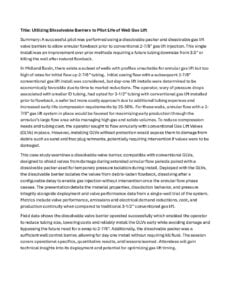Utilizing Dissolvable Barriers to Pilot Life of Well Gas Lift
by:
Craig Beanland – Oxy
Summary: A successful pilot was performed using a dissolvable packer and dissolvable gas lift valve barriers to allow annular flowback prior to conventional 2-7/8” gas lift injection. This single install was an improvement over prior methods requiring a future tubing downsize from 3.5” or killing the well after natural flowback.
In Midland Basin, there exists a subset of wells with profiles unsuitable for annular gas lift but too high of rates for initial flow up 2-7/8” tubing. Initial casing flow with a subsequent 2-7/8” conventional gas lift install was considered, but day-one lift installs were determined to be economically favorable due to time to market reductions. The operator, wary of pressure drops associated with smaller ID tubing, had opted for 3-1/2” tubing with conventional gas lift installed prior to flowback, a safer but more costly approach due to additional tubing expenses and increased early-life compression requirements by 25-50%. For these wells, annular flow with a 2-7/8” gas lift system in place would be favored for maximizing early production through the annulus’s large flow area while managing high gas and solids volumes. To reduce compression needs and tubing cost, the operator sought to flow annularly with conventional Gas Lift Valves (GLVs) in place. However, installing GLVs without protection would expose them to damage from debris such as sand and frac plug remnants, potentially requiring intervention if valves were to be damaged.
This case study examines a dissolvable valve barrier, compatible with conventional GLVs, designed to shield valves from damage during extended annular flow periods paired with a dissolvable packer used for temporary pressure isolation during install. Deployed with the GLVs, the dissolvable barrier isolates the valves from debris-laden flowback, dissolving after a configurable delay to enable gas injection without intervention once the annular flow phase ceases. The presentation details the material properties, dissolution behavior, and pressure integrity alongside deployment and valve performance data from a single-well trial of the system. Metrics include valve performance, emissions and electrical demand reductions, cost, and production continuity when compared to traditional 3-1/2” conventional gas lift.
Field data shows the dissolvable valve barrier operated successfully which enabled the operator to reduce tubing size, lowering costs and reliably install the GLVs early while avoiding damage and bypassing the future need for a swap to 2-7/8”. Additionally, the dissolvable packer was a sufficient well control barrier, allowing for day one install without requiring kill fluid. The session covers operational specifics, quantitative results, and lessons learned. Attendees will gain technical insights into its deployment and potential for optimizing gas lift timing.

